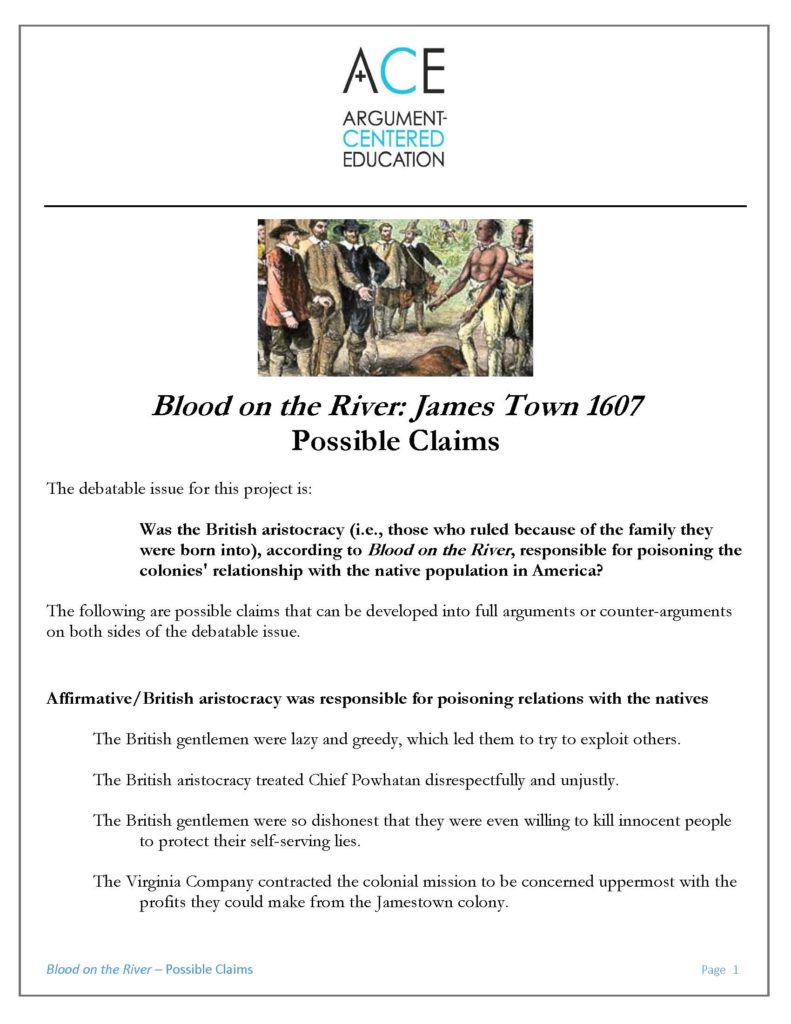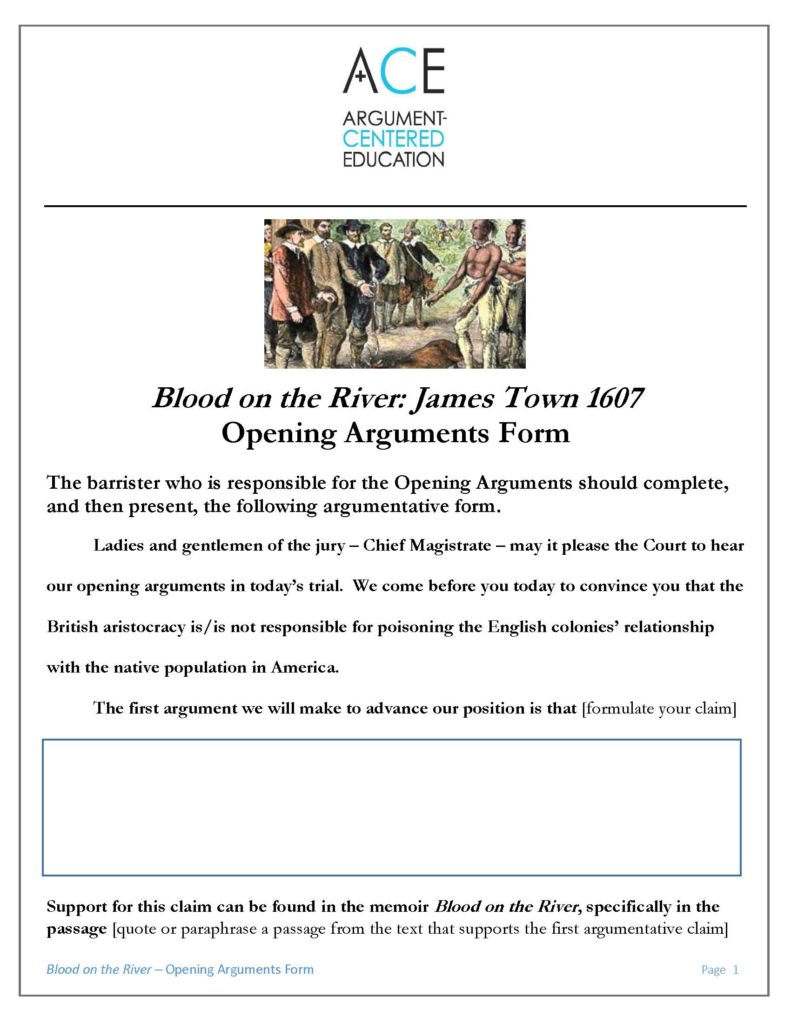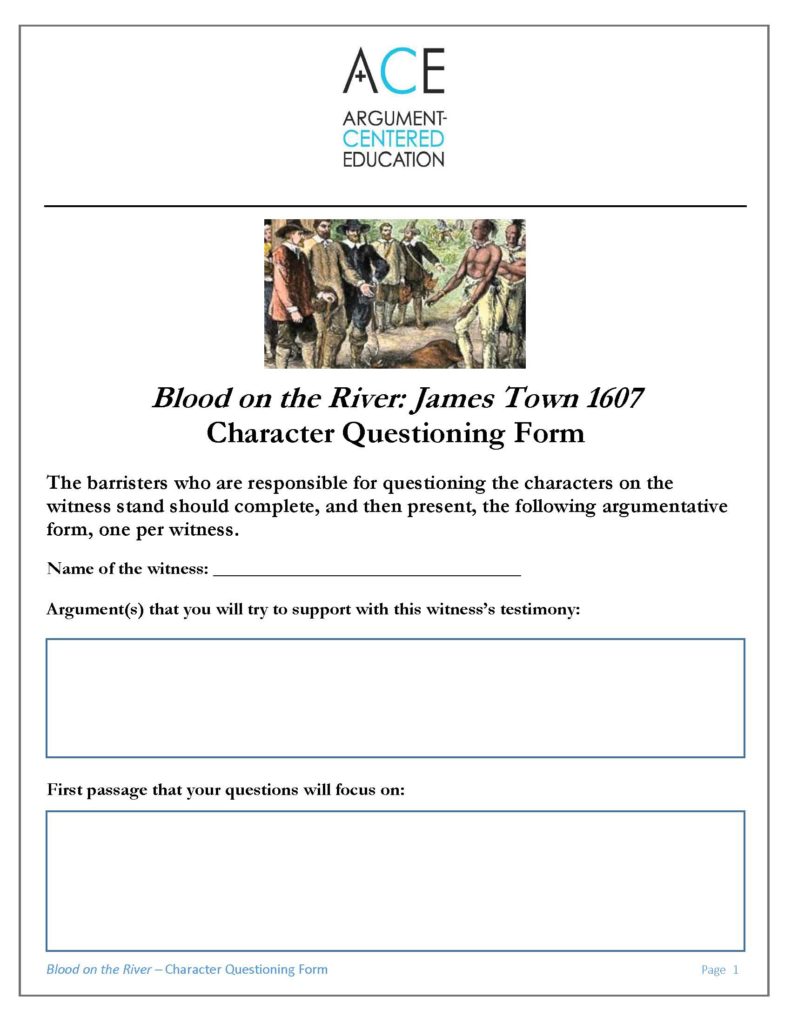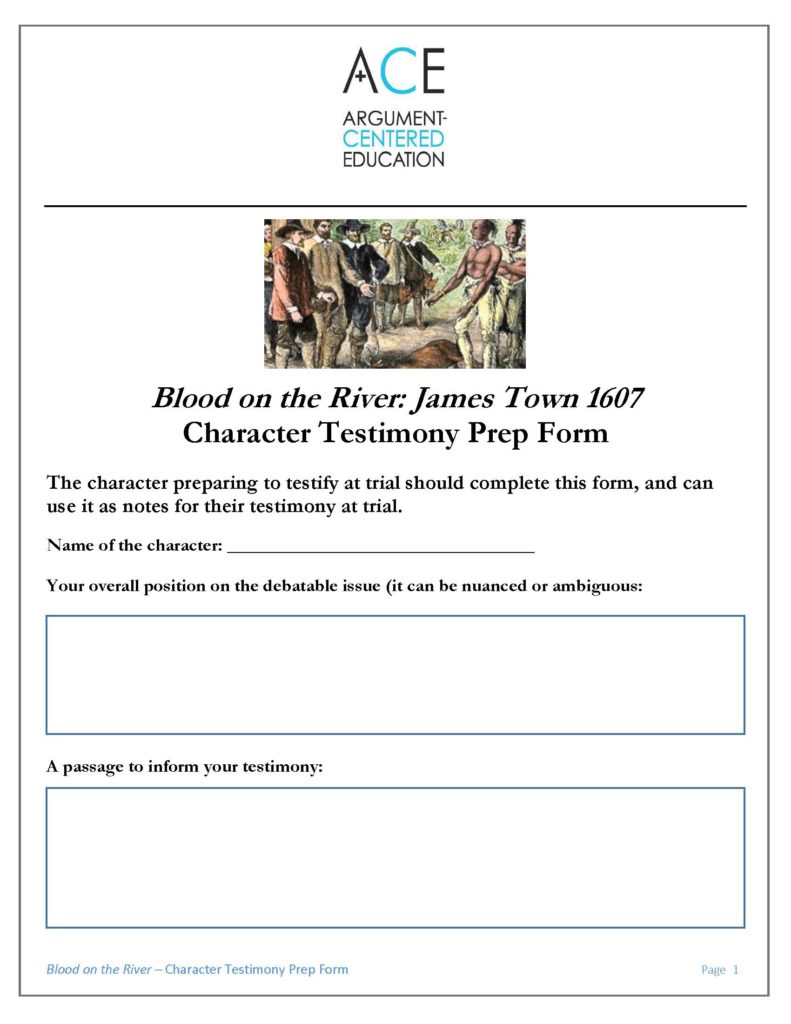
Mock Trial: Investigating the Origin of the Oppression of Native Americans
Overview
Blood on the River is a very well-regarded 2006 young adult historical novel by Eliza Carbone. Told from the point of view of 12 year old English orphan Samuel Collier, it is set in 1606 – 1611 and tells the story of the settlement of the Jamestown colony in Virginia, from the erection of the first domiciles, to the building of the fortress that would protect the fragile colony, to the “Starving Time” in the winter of 1609-10, and beyond.
Threaded throughout the novel there are conflicts between the British aristocracy (which both sponsors the trip, in the form of the Virginia Company, and leads it, in the persons of several Captains) and commoners, and between the colonists and the native population of Virginia. These conflicts form the heart of the novel’s concerns and interests. This argument-based project brings these conflicts together in a debatable question that plays itself out in the classroom in the form of a mock trial that puts the British aristocracy on trial for, in effect, originating the violent oppression of the Native American population that Blood on the River anticipates and (in its closing pages) foretells.
Debatable Issue
Was the British aristocracy (i.e., those who ruled because of the family they were born into), according to Blood on the River, responsible for poisoning the colonies’ relationship with the native population in America?
Method and Procedure
The Blood on the River Mock Trial should be conducted after the class has finished reading the novel, though it is important that the debatable issue be introduced early in the unit, and that important passages be analyzed in relation to the debatable issue.
(1)
Review the debatable issue with the class, asking students to define key terms like “aristocracy,” “poisoning,” “responsible,” and “native population,” possibly in a Bell Ringer that you then discuss, or with terms hanging around the classroom on chart paper.
(2)
Orient students on the Mock Trial project by going over the procedure, identifying objectives, and work products and assessment criteria. You should choose the objectives to identify from among the possible argumentation and literacy skills implicated in the project, and depending on students’ developmental levels and needs.
(3)
Conduct a Think-Pair-Share that brainstorms a list of possible argumentative claims on each side of the debatable issue. At this stage of the project focus only on possible argumentative claims, do not involve evidence and reasoning for those claims. Ask each pair to formulate two argumentative claims on each side of the issue – so four total. Share out those claims to generate a master list on the board or projector. Do not repeat claims – if a pair shares out a claim already on the list, either don’t write it or use it to replace a lesser formulation of the same claim.
Then distribute the Possible Claims document and add any on it to the master list of claims that the class has generated, or use it to improve the formulation of any of the student-generated claims.

(4)
Assign each student a role in the Mock Trial. There are two role categories: barristers and characters. There will actually be two Mock Trials in this project – each conducted by one-half of the class – and when the other half of the students are not acting as barristers or characters, they make up the jury, determining the verdict in the Mock Trial.
The Mock Trial is designed optimally to involved four barristers on each side, so eight barristers total. And there are eight characters to take part in the trial as well. Those characters are:
Samuel Collier
Reverend Hunt
Namontack
Captain Christopher Newport (Aristocrat)
Chief Powhatan
Captain John Ratcliffe (Aristocrat)
Captain John Smith
Master Edward Wingfield (Aristocrat)
This means that the optimal number for each Mock Trial is 16 students. If your class has fewer than 32 students, you should have some number of the characters perform in both trials. If you have fewer than 24 students in the class, you can reduce the number of barristers on each side to three, or you can reduce the number of characters that take part in the trial.
(5)
Distribute copies of the Selected Passages document to both sides. Discuss how these passages can be used to support arguments that each side will want to make at trial. The text of the novel should be considered the transcript of an extended memoir of the period written by Samuel Collier, with the reputation as having accurately captured and recorded events that occurred and statements made during the Jamestown settlement of 1607 – 1611.

(6)
Each team of barristers should sub-divide into individual responsibilities. One should prepare and deliver the Opening Arguments. Two should prepare and deliver questions for the eight characters (so four characters per barrister). And one should prepare and deliver the Closing Statement.
(7)
The barrister responsible for the Opening Arguments should lead a discussion among the full team of barristers about which three of the argumentative claims the team wants to focus on. She should then use the Opening Arguments Form to build those arguments into the substance of an argumentative speech that will make up the opening stage of the trial.

(8)
The barristers responsible for the questioning of the characters should first divide the eight characters, and then complete Character Questioning Forms, one for each character they are preparing to question.

(9)
The barrister responsible for the Closing Statement should work with her fellow barristers to help support their work on developing the three arguments that the team has agreed to build and advance at trial. The Closing Statement cannot be prepared in advance, like the Opening Arguments can be, since it has to be responsive to the other side’s arguments, and it has to try to use as much of the character testimony to support its extension of its sides arguments as possible. But the barrister can review evidence from the selected passages to become familiar with the strongest support for its side’s arguments. This barrister will be responsible for completing the Argument Refutation Form during the trial and submitting it for assessment at the end of the trial.
(10)
The characters should each complete a Character Testimony Prep Form. They should read the Selected Passages carefully, and scan through the entire novel looking for places in which they personally appear in the narrative, giving them clues as to how they would answer the questions in preparation for the testimony that they will give at trial. Their responses should be as text-based as possible.

(11)
When everyone has been given ample time to prepare for trial, completing the forms that they will submit as part (possibly half) of their grade for the project, the Mock Trial should begin. You should act as the Chief Magistrate, moderating and managing the proceedings.
The format for the Mock Trial is below.
Chief Magistrate’s Calling to Order and Review of Procedure (3 Minutes)
Opening Arguments from the Prosecution (6 Minutes)
Opening Arguments from the Defense (6 Minutes)
Character Testimony
Captain Christopher Newport
Examination by Prosecution (3 Minutes)
Cross-Examination by Defense (3 Minutes)
Master Edward Wingfield
Examination by Prosecution (3 Minutes)
Cross-Examination by Defense (3 Minutes)
Captain John Smith
Examination by Prosecution (3 Minutes)
Cross-Examination by Defense (3 Minutes)
Chief Powhatan
Examination by Prosecution (3 Minutes)
Cross-Examination by Defense (3 Minutes)
Captain Christopher Newport
Examination by Defense (3 Minutes)
Cross-Examination by Prosecution (3 Minutes)
Reverend Hunt
Examination by Defense (3 Minutes)
Cross-Examination by Prosecution (3 Minutes)
Namontack
Examination by Defense (3 Minutes)
Cross-Examination by Prosecution (3 Minutes)
Samuel Collier
Examination by Defense (3 Minutes)
Cross-Examination by Prosecution (3 Minutes)
Closing Statement from the Defense (6 Minutes)
Closing Statement from the Prosecution (6 Minutes)
(12)
The members of the jury should be taking careful notes throughout the trial. When the trial is over they should vote separately and independently for the side that they think that won in trial. The prosecution has the burden of proof – in a tie, the defense should win and be given a juror’s vote. That is why the prosecution speaks first and last at trial. Juror members should complete their Juror Evaluation Form and submit it.
You should collect and assess every student’s form after each Mock Trial. You should assess students about half on their preparation and about half in their performance at trial. Discuss with students what went well in the Mock Trial, and what they can improve upon next time.


